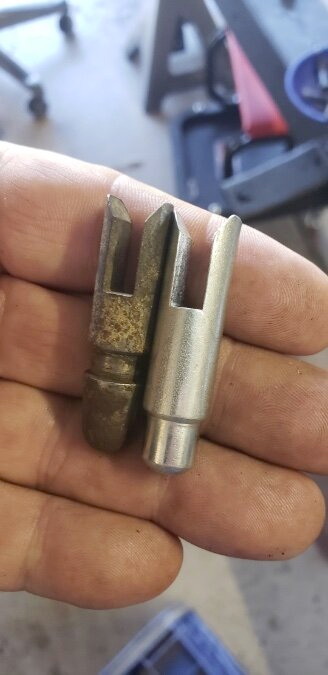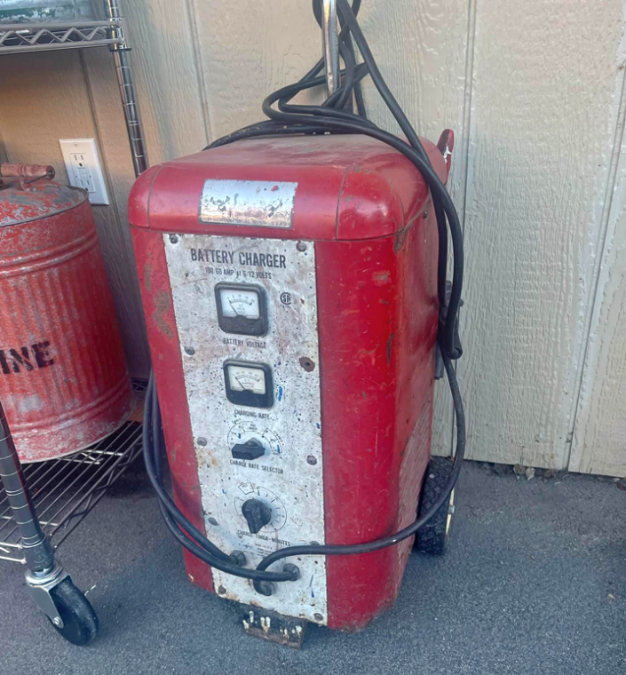-
Posts
3,467 -
Joined
-
Last visited
-
Days Won
193
Content Type
Links Directory
Profiles
Articles
Forums
Downloads
Store
Gallery
Blogs
Events
Everything posted by keithb7
-
That timing chain was done when Buzz landed on the moon. Suggest upgrading to strutted chain and sprockets. More robust. Springs are cheap. I suggest Buy 12. See Andy Bernbaum. You can view my updated chain and gears here: Goto 3:22 mark.
-

Crimp on terminals for brake light switch wiring?
keithb7 replied to Racer-X-'s topic in P15-D24 Forum
I too am a couple years into cheapo female connectors. I trim and tin the wires. Side connector on. Crimp. Then solder. Then heat shrink over top. -
Vapor lock solutions in 50 words or less: 1. Non-ethanol Fuel 2. 6V Electric Priming Pump w/toggle switch 3. Fuel pump heat shield 4. Thin metal base plate at carb base 5. Phenolic spacer adaptor at carb base Two other options I have not tried: Heat shield around fuel lines. Cloths pins, I simply refuse to try this.
-
Every time I take my '38 car out, on the way home every time , it's wide open mashed in 3rd for about 3 miles up the hill home. My modern vehicles record very poor average MPG. I really don't want to know what my flathead would net. Unfortunately no, I cannot answer the original question. Sadly we hi-jacked the thread. Yet it was a fun discussion. Sorry. I'm guilty.
-
Every time I take one my cars out, I get approached. People ask questions. They want to take photos. Sometimes I pop the hood and proudly display the engine. I beam about Chrysler engineering as I point out the hidden unknown things from 1938. Imagine the embarrassment when I opened the hood to show them clothes pins! Nope. Not gonna happen. Not on my watch Walter P.
-
I’m too proud to put wooden clothes pegs on my fuel lines. I’ll try almost anything else. Lol.
-
We get over 100F every summer. Not uncommon to hit above that. Past summer we hit 118F. No shortage of big hills around here in my town. My town is built on the hills. Vapor lock is indeed a reality. The engines run pretty warm. The old rads and 4 blade fans can only do so much. The car can only move up a long hill so fast with a 119 HP flathead. You just can’t move a lot of air.
-
Here in Canada we have 2 options for fuel without ethanol. Marine grade which is 92 octane. It’s also illegal to burn it in a non marine vehicle. The other option is Supreme Plus 94 octane. Only at Chevron. Its priced like nectar for the gods. So we have the option to break the law and fill jerry cans of marine fuel. Then take them home and fill our vintage cars. Or pay thru the nose for the nectar. If you run a mechanical fuel pump, stock system you increase the risk for vapor lock in hot weather. One could choose to add an electric fuel pump to push thru any possible vapor lock. I’m all ears for other options.
-
Doing the calculations we are currently nearing $6.15 US dollars per US gallon. For regular, 89 grade with about 10% ethanol.
-
Canuck here, educated my entire school years in the decimal system. Metric. Yet I cannot think of elevation in meters. Gotta be feet. Fuel, well liters/per 100Km sounds cheaper sounding than mile per gallon. 5.0L per 100 km is about 47 mpg. My wife's turbo Honda 1.5L car got just under 5.0L per hundred km in the California desert. Between Barstow and Needles if I recall. Never saw it since, but it was epic. We've been metric in Canada for almost 50 years. Yet when we go to the grocery store produce is still to this day, priced per pound. Its bizzarre. It sounds cheaper at 1.25/lb for apples versus 2.75 per kg. So if they must price in metric they'll so 27.5 cents per 100 grams. Which is pretty useless for apples. 100g gets you a slice of an apple by weight. Or something like that. I'm now totally confused. All I know is it doesn't matter if gas prices go up. Or if it's metric or not. I just put in $20 every time I need gas. I don't see gas price increases affecting my old flathead at all. ?
-

How many feet of wire to get for a full rewire?
keithb7 replied to Wood and Steel's topic in P15-D24 Forum
Consider upsizing your gauge. Especially to the headlights. Wouldn't hurt to get as many amps as you can out there and back. Are you making your own harnesses? Its fun, and very satisfying. -
You can also put the cable end in a vice. Cup upward. Heat it up with propane torch. Melt lots of solder in there. A nice cauldron it becomes. Be on the ready with your battery cable already stripped back the right amount. Push the exposed copper strand end, into the hot vat of solder. Push it in hard. Hit the bottom. And be quick like a bunny. It cools and is glued in there real good. It works and you can make your own cables at home. As good as crushed mechanical connection? Not quite probably. @Sniper can confirm. We are very fortunate have a resident industrial electrical coach here. For me many years later, I still have battery cables working fine. 6V and 12V. Cars and diesels start up well. I probably should think about a tool to crush cable ends. But what fun would that be? You know, risking mechanical reliability to save a couple bucks.
-
Get a longer wood dowel. Small diameter that fits down in your pipe plug hole iin the head over #6. Stoke can't be any longer than 4 3/4 so get a 8" or so long dowel. Loosen all spark plugs to relive compression. Turn engine fan by hand. Look at rotor under distributor cap. Note where wire to #1 spark mounts in the cap. Usually around 7pm on a clock. Scribe top round edge of distributor housing if you like. Then move the distributor cap out of the way. Turn engine over by hand to just before the rotor points to plug wire position to #1 cylinder. Slow down, watch your dowel in #6. When it reaches the very top and starts to come down again, back the engine up slightly. Stop where the dowel is at its highest point. That's TDC #1. Mark your fan blade if you want. Reference it with a mark on the rad maybe. Look down at the timing marks on the crank shaft. 0 should be right under the pointy arrowhead that is attached to the front timing cover. A flash light is a big help here! We know the firing order is 1,5,3,6,2,4. Every 120 deg of fan blade rotation (1/3 of a circle) the next cylinder is at TDC. Watch your marked fan blade. Turn it 120 degrees. Then you are on TDC #5, again 120 deg to TDC #3, Then turn it another 120 degrees then you are on # 6. By this time you have covered a full 360 degrees. The mark on your fan blade should line up exactly where your mark is on the radiator again. You've come full circle. Your dowel in the hole #6 is at its very top again. The pointy thingy on the timing chain cover is at 0 on the crank pulley again. Keep going, 120 then you are on# 2. Then finally 120 again to #4. 120 one more time and you are back at #1 TDC. Fan blade and rad marks line up once again and wood dowel is back at the very top where it started. To be "fer sure, fer sure" you cold pull side valve covers off and check the pair of tappets for cylinder you are aiming for. The tappets will both be loose, the amount of valve tappet clearance spec. You can pull and wiggle the tappet upwards 8 or 10 thou. Then you know both valves are perfectly closed at your cylinder of choice. Might as well set those tappets when you are in that far! Nothin' to it by now. You've already cussed up a storm likely by now. Hurt your back. Dropped two screw drivers and a wrench 3 times. Congratulations you're 90% there to completing a full tappet set yourself!
-
Old cars are great in some areas. No so in others. I do love their simplicity. Yes indeed flathead Mopars are super easy to work on. My old cars do break down from time to time. Mainly because I treat them as lab experiments sometimes. (let's try this & see what happens) Is there a better way to learn than from your own stupid decisions? Lol. Just this past weekend even we had an incident where I thought...Better dig out the AAA card. Yet I always fix them up and get them home under their own power. Never needed a tow truck to get home yet! Knock on wood. Try that with a new car that needs semi-conductors to breathe fire.
-
Ignore the polarity of the car’s electrical system. Just look at the battery. The Positive post on the battery gets the red clamp from the battery charger. Negative battery post gets the black clamp. Just make sure it’s 6V charger!
-
I am currently in my 5th year with a 6V flooded wet cell battery. Its just a run of the mill general battery. It sits every winter from about Nov 1 to Mar 15. I do top it up with a .75A 6V charger about every 3-4 weeks while in hibernation. No complaints. It fired up my 265 ci engine no problem. Still unknown how long it’ll last as I still use it.
-
Based on my recent Engine Overhaul Generally Reused: (if good) Flywheel. Front pulley. Oil pan & plug. Valve covers. Front cover. Main and con-rod caps. Oil tubes and suction screen. Intake & exhaust manifolds. Some hardware. Bell housing. Recondition: block, head, crank.,con-rods, exhaust manifold diverter valve. Distributor assembly. New: Oil pump, valves & retainers, tappets, valve springs, valve guides, pistons. Piston pins & pin retainers, pistons, rings, piston pin bushings, con-rod bearings. Main bearings. Timing chain and gears. Head bolts. All seals and gaskets. Spark plugs. Spark plug & coil wires. Water distribution tube. Fuel filter. Oil filter. Oil pressure gauge flex hose. Fuel pump flex hoses. Expansion plugs. Thermostat. Distributor cap, rotor, condenser. Possible new, recondition, or re-use if pass inspection: Con-rod bolts. Water pump. Clutch disc & pressure plate. Mechanical fuel pump. Rad hoses. Heater hoses. Hose clamps. Fuel line hoses. Fuel pump. Camshaft & thrust plate. Starter & battery cables. Battery. Generator. Carburetor. Oil pressure relief plunger & spring. Choke system. Fan belt. Radiator. 6V coil. Points wire from coil to distributor. Throttle linkage & return springs. Flywheel ring gear. I probably missed listing a couple things.
-
I dunno but does that guy touch a 200F valve train with bare hands at the 4:30 mark? Does a fully warmed up hot engine smoke a little when the valve covers are freshly cracked open?
-
These guys did alright by me. I upped my 228 ci engine to a 237 ci. Got 98% of my internal engine parts from VPW. https://www.vintagepowerwagons.com/online-parts-catalog No I don't have a Power Wagon. A 38 Sedan. Yet, with a little research you'll learn internal parts are very similar.
-

Can't get front brake shoes to go in so drum will fit on 48 DeSoto.
keithb7 replied to MarcDeSoto's topic in P15-D24 Forum
I put some new Andy Bernbaum shoes on the LF wheel this week. Sure, they should have been arc'd. I ran them as-is and went for a few drives. No more pulling to the left! Lol. No they don't contact the drum like they should, and the contaminated removed shoes are gone! Couple of trips down the hill with ample braking, they'll arc themselves in. I am on the adjusters very often. They are already improving, I can feel it. But no, I had no trouble getting the drums over the new shoes. I did put the new shoe inside the drum and held it in place. I used a feeler gauge. Out at the ends I measured about 0.019 at the toe, and about 0.014 at the heel. I don't necessarily recommend everyone do what I did. Yet these brake pins. These pesky little brake shoe pins. How often do they really need replacing? For the most part, the are pretty much non-wearing aren't they? If the old pins worked, re-use them. I suppose with leaking brake fluid getting on them, left in a field for 50 years, they rust some. 50 years in a field seems to be a pretty common theme. I have yet to dive into a failure analysis of these brake pins. -
The fuel pressure problem was with my 1938 Chrysler Coupe. When I bought it, it had the incorrect fuel pump on it. It was making too much pressure. So the previous owner installed a regulator. My 1938 Sedan Plymouth has no such problem. I don't think I have produced a video on my Sedan fuel system.
-
No. Not at all. The electric does not run full time. Only when I want to prime the system. Or suffer a little vapor lock on a hot summer Kamloops day. I can purge fuel through the system by cycling the fuel pump if needed. Sort of a little turbo boost for the stock mechanical system. The switch, I mounted it easily within grasp of me while driving. The electric pump I run only makes about 4-5 psi pressure.
-
Longer cranking times after sitting for a few weeks is normal. Fuel system pressure in the lines drops. Cranking the engine over operates the mechanical fuel pump. It takes some time to refill the fuel system and get fuel up to the bowl, and into the intake manifold. Larger battery cables won't hurt, but may not alleviate the delayed fuel delivery. It may a little, if the engine is cranking over faster than with smaller cables. However just larger cables may only be part of the solution. A solution that works extremely well for me, is the 6V electric fuel pump. In-line. Mine is after the mechanical fuel pump and still works just fine. I get in the car, Turn the key on to power the system, flip on the electric fuel pump switch for 10 or so seconds. It fills the fuel lines and builds pressure. Fills the float bowl. I turn off the electric pump. Then I pump the gas pedal 1 time. This cycles a raw jet of fuel from the accelerator pump in to the carb venturi. Then I crank the starter over and the engine starts very quickly. Eliminating all strain on the starter. I run and drive with the mechanical, stock fuel pump. It helps tremendously to have a healthy, well tuned engine as well. Good compression. No carb air leaks, working choke, spark, timing, dwell, good sealed valves, no vacuum leaks. These all go a long ways for a quick starting engine! I am a believer after the massive improvements I see consistently every time I start my fresh rebuilt engine.
-

Increasingly Difficult To Find Manual 6V Battery Chargers
keithb7 replied to keithb7's topic in P15-D24 Forum
-
Sure weird how the trip around the sun is way faster later in life. As a kid summers off school felt practically indefinite. Today an entire orbit goes by much quicker. Unless of course you’re waiting for knee surgery. Or house guests to leave lol. Then time drags on!







